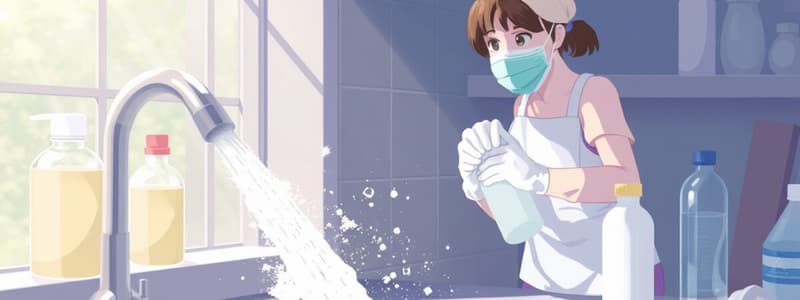Podcast
Questions and Answers
Define Cleaning.
Define Cleaning.
Removes food and other dirt from surfaces.
Define Sanitizing.
Define Sanitizing.
Reduces pathogens on a surface to safe levels.
Cleaners must be what?
Cleaners must be what?
Stable, noncorrosive, and safe to use.
Can cleaners be dangerous?
Can cleaners be dangerous?
Food-contact surfaces MUST be SANITIZED after they have been what?
Food-contact surfaces MUST be SANITIZED after they have been what?
How can food-contact surfaces be sanitized?
How can food-contact surfaces be sanitized?
How do you sanitize by the heat method?
How do you sanitize by the heat method?
What are the two ways to heat sanitize?
What are the two ways to heat sanitize?
How can you sanitize tableware, utensils, and equipment with chemicals?
How can you sanitize tableware, utensils, and equipment with chemicals?
What are the 3 common types of chemical sanitizer?
What are the 3 common types of chemical sanitizer?
Who governs or regulates chemical sanitizers?
Who governs or regulates chemical sanitizers?
What factors influence the effectiveness of chemical sanitizers?
What factors influence the effectiveness of chemical sanitizers?
What does sanitizer concentration mean?
What does sanitizer concentration mean?
How is sanitizer concentration measured?
How is sanitizer concentration measured?
What do you use to measure sanitizer concentration?
What do you use to measure sanitizer concentration?
What temperature should water be for sanitizing solution?
What temperature should water be for sanitizing solution?
What is water hardness?
What is water hardness?
How do you find out what your water hardness is?
How do you find out what your water hardness is?
Due to water hardness, how do you know the amount of sanitizer to use?
Due to water hardness, how do you know the amount of sanitizer to use?
How do you find out what your water pH is?
How do you find out what your water pH is?
Due to water pH, how do you know the amount of sanitizer to use?
Due to water pH, how do you know the amount of sanitizer to use?
What is the water temperature for chlorine when water pH is ≤10?
What is the water temperature for chlorine when water pH is ≤10?
What is the water temperature for chlorine when water pH is ≤8?
What is the water temperature for chlorine when water pH is ≤8?
What is the sanitizer concentration for chlorine for either ≤8 or ≤10 water pH?
What is the sanitizer concentration for chlorine for either ≤8 or ≤10 water pH?
What is the sanitizer contact-time for chlorine for either ≤8 or ≤10 water pH?
What is the sanitizer contact-time for chlorine for either ≤8 or ≤10 water pH?
What is the water temperature for iodine?
What is the water temperature for iodine?
What is the water pH for iodine?
What is the water pH for iodine?
What should sanitizer concentration be for iodine?
What should sanitizer concentration be for iodine?
What is the sanitizer contact-time for iodine?
What is the sanitizer contact-time for iodine?
What is the water temperature for quats?
What is the water temperature for quats?
What is the water pH for quats?
What is the water pH for quats?
What should sanitizer concentration with hard water be for quats?
What should sanitizer concentration with hard water be for quats?
What should sanitizer concentration be for quats?
What should sanitizer concentration be for quats?
What is the sanitizer contact-time for quats?
What is the sanitizer contact-time for quats?
What must be cleaned and rinsed in any establishment?
What must be cleaned and rinsed in any establishment?
All surfaces that touch food must be what?
All surfaces that touch food must be what?
How do you clean and sanitize a surface?
How do you clean and sanitize a surface?
When to clean all food-contact surfaces?
When to clean all food-contact surfaces?
What are the steps for cleaning and sanitizing stationary equipment?
What are the steps for cleaning and sanitizing stationary equipment?
How often should Clean-In-Place equipment (like a soft-serve yogurt machine) be cleaned?
How often should Clean-In-Place equipment (like a soft-serve yogurt machine) be cleaned?
Dish washing machines sanitize by using either?
Dish washing machines sanitize by using either?
What temperature must a high-temperature machine's final sanitizing rinse be?
What temperature must a high-temperature machine's final sanitizing rinse be?
What temperature must a high-temperature machine that has a stationary rack, single temperature be?
What temperature must a high-temperature machine that has a stationary rack, single temperature be?
Chemical-sanitizing machines should follow what guidelines?
Chemical-sanitizing machines should follow what guidelines?
What are recommended guidelines for dish washing machines?
What are recommended guidelines for dish washing machines?
What is the purpose of a three-compartment sink?
What is the purpose of a three-compartment sink?
How do you set up a three-compartment sink?
How do you set up a three-compartment sink?
How to clean and sanitize in a three-compartment sink?
How to clean and sanitize in a three-compartment sink?
How far off the floor do you store clean and sanitized tableware and utensils?
How far off the floor do you store clean and sanitized tableware and utensils?
The storage surface for tableware and utensils should be what?
The storage surface for tableware and utensils should be what?
What kind of pathogen can be transferred if staff mishandles glasses and flatware?
What kind of pathogen can be transferred if staff mishandles glasses and flatware?
How should food-service chemicals be stored?
How should food-service chemicals be stored?
If chemicals are transferred to a new container, they must have what?
If chemicals are transferred to a new container, they must have what?
What is the proper way to dispose of chemicals?
What is the proper way to dispose of chemicals?
Who requires chemical manufacturers and suppliers to provide MSDS for each hazardous chemical?
Who requires chemical manufacturers and suppliers to provide MSDS for each hazardous chemical?
What are MSDS?
What are MSDS?
What information is found on a MSDS?
What information is found on a MSDS?
What is PPE?
What is PPE?
When developing an effective cleaning program you must focus on three things, what are they?
When developing an effective cleaning program you must focus on three things, what are they?
A master cleaning schedule should have what information on it?
A master cleaning schedule should have what information on it?
What is required for measuring the sanitation rinse temperature in a high-temperature dish washing machine?
What is required for measuring the sanitation rinse temperature in a high-temperature dish washing machine?
What is sanitizing?
What is sanitizing?
If food-contact surfaces are in constant use, how often must they be cleaned and sanitized?
If food-contact surfaces are in constant use, how often must they be cleaned and sanitized?
What must food handlers do to make sure sanitizing solutions for use on food-contact surfaces has been made correctly?
What must food handlers do to make sure sanitizing solutions for use on food-contact surfaces has been made correctly?
What should be done when throwing away chemicals?
What should be done when throwing away chemicals?
How should flatware and utensils that have been cleaned and sanitized be stored?
How should flatware and utensils that have been cleaned and sanitized be stored?
What is the correct way to clean and sanitize a prep table?
What is the correct way to clean and sanitize a prep table?
What is the first step of cleaning and sanitizing stationary equipment?
What is the first step of cleaning and sanitizing stationary equipment?
What temperature should the water be for manual dish washing?
What temperature should the water be for manual dish washing?
What organization requires a Material Safety Data Sheet (MSDS) to be included with hazardous chemicals?
What organization requires a Material Safety Data Sheet (MSDS) to be included with hazardous chemicals?
What must staff members do when transferring chemicals to a new container?
What must staff members do when transferring chemicals to a new container?
What temperature must a high-temperature dishwasher's final sanitizing rinse be?
What temperature must a high-temperature dishwasher's final sanitizing rinse be?
How should staff make sure the chemical sanitizer being used on a food-prep surface is at the correct strength?
How should staff make sure the chemical sanitizer being used on a food-prep surface is at the correct strength?
Flashcards are hidden until you start studying
Study Notes
Definitions
- Cleaning involves removing food and dirt from surfaces.
- Sanitizing reduces pathogens on surfaces to safe levels.
Cleaners and Safety
- Cleaners must be stable, non-corrosive, and safe for use.
- Incorrect use of cleaners can lead to dangerous outcomes.
Sanitizing Requirements
- Food-contact surfaces must be sanitized after they are cleaned and rinsed.
- Sanitization can be done using heat or chemical methods.
Heat Sanitization
- The heat method involves soaking surfaces in hot water at 171°F for at least 30 seconds.
- Methods for heat sanitizing include soaking or using a high-temperature dishwasher.
Chemical Sanitization
- Tableware, utensils, and equipment can be sanitized by soaking or spraying with sanitizing solutions.
- Common types of chemical sanitizers include chlorine, iodine, and quaternary ammonium compounds (quats).
- Regulatory oversight for chemical sanitizers is provided by state and federal environmental agencies (EPA).
Factors Affecting Chemical Sanitization
- Effectiveness depends on concentration, contact time, pH, temperature, and water hardness.
- Concentration of sanitizer is a mixture of the chemical and water, measured in parts per million (ppm).
Water Requirements for Sanitization
- Water temperature for sanitizing solutions should align with manufacturer recommendations.
- Water hardness refers to the mineral content in water, affecting sanitizer effectiveness.
Sanitizer Specifics
- Chlorine sanitizing requires a minimum temperature of ≥100°F when pH is ≤10, and ≥68°F when pH is ≤8, with a concentration of 50-99 ppm and a contact time of ≥7 seconds.
- Iodine should be used at a temperature of 68°F with a pH of ≤5, having a concentration of 12.5-25 ppm and a contact time of ≥30 seconds.
- Quaternary ammonium compounds (quats) require 75°F water with a concentration as per manufacturer recommendations and a contact time of ≥30 seconds.
Cleaning Procedures
- All surfaces must be cleaned and rinsed consistently, especially food-contact surfaces.
- Cleaning and sanitizing of surfaces includes scraping, washing, rinsing, sanitizing, and air-drying.
- Regular cleaning is necessary before, during, and after the use of different food types, or every 4 hours for constant use.
Equipment Cleaning Steps
- Cleaning stationary equipment involves unplugging, removing parts, scraping food residue, washing, rinsing, sanitizing, and air-drying.
- Clean-in-place equipment must be cleaned daily unless specified otherwise by the manufacturer.
Dishwashing Methods
- Dishwashing machines sanitize through hot water or chemicals.
- Final sanitizing rinse temperature must be at least 180°F for high-temperature machines.
Three-Compartment Sink Setup
- Set up requires washing, rinsing, and sanitizing with specific temperature controls and proper surfaces.
Safe Storage Practices
- Clean and sanitized items must be stored at least 6 inches off the ground.
- Utensils should be stored with handles facing up to prevent contamination.
Chemical Storage and Handling
- Food-service chemicals must be kept in original containers, away from food preparation areas.
- Any chemical transfer to a new container requires proper labeling.
Regulatory Compliance
- The Occupational Safety and Health Administration (OSHA) mandates the provision of Material Safety Data Sheets (MSDS) for hazardous chemicals, including safety and handling information.
Personal Protective Equipment (PPE)
- Use of PPE is necessary when handling chemicals to ensure safety during cleaning processes.
Cleaning Program Essentials
- An effective cleaning program includes a master cleaning schedule, staff training, and ongoing monitoring for compliance and effectiveness.
Studying That Suits You
Use AI to generate personalized quizzes and flashcards to suit your learning preferences.



